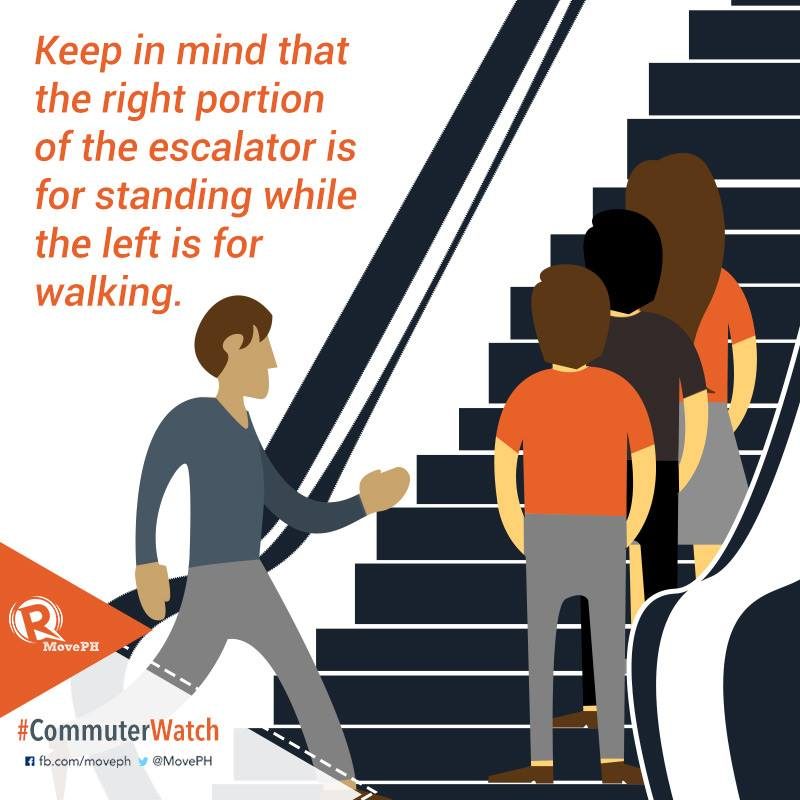SUMMARY
This is AI generated summarization, which may have errors. For context, always refer to the full article.

MANILA, Philippines – Stand on right and walk on left – it’s a general rule of thumb, they said. But why isn’t this being practiced in the Philippines, especially in public train stations?
Earlier, MovePH posted a #CommuterWatch graphics on the right way of using escalators and it generated mixed reactions from netizens.
//Not rushing? Just keep right! #CommuterWatch
Posted by Move.PH on Tuesday, September 29, 2015
Norm everywhere?
On escalators around the world, there are always two types of people – one who walks and one who stands. To manage human traffic, many countries follow the ‘stand on right and walk on left’ rule. Other countries, like Malaysia, New Zealand, Japan, and Australia, have it the other way around where the slow lane is on the left and the fast lane is on the right.
In the Philippines, however, neither is being practiced. This is despite signs posted at MRT stations and some malls which instruct people to keep the left side free for rushing individuals.
According to Bones Palanca on Facebook, there could be two reasons why this is not yet a norm in the country: one, we have never fully adopted this, and two, the signs are not clear and concise.
“[K]asi sa ibang bansa, mas malinaw. May linya ang escalator. Sa escalator mismo nakasulat na walk and stand,” Palanca added.
(Signs in other countries are clearer. There are lines and signs which explicitly tells people where to walk and stand)
To address this, Philip Bisnon and Victor Rivera II suggest adding big yellow signs on escalators to instruct standing people to keep right.
Alexei Betos, on the other hand, provides a more comprehensive suggestion: “In other countries, these were taught in schools, just like how to commute, how to follow road signs and etc. I hope that the Department of Education will finally integrate these to the curriculum.”
Shekinah Arielle Torreno, on the other hand, said that common decency should prompt everyone to heed the rule. “We want change? Let’s change the way we do simple things everyday like we are all educated people,” she added.
Should we apply it here?
Despite the system being a norm everywhere, some Filipino netizens also raised doubts whether it would be wise to adopt the policy in the country – mostly for safety reasons.
Mark Paul Lomod, who experienced being apprehended in another country for not following the policy, suggests that rushing individuals could just take the stairs. “I doubt the movement of the escalator would even provide a noticeable improvement in your pace anyway,” Lomod added.
Jay N. Ramos echoed this, and said that “walking up or down a crowded escalator is downright dangerous, as one little slip can make you knock down people like a line of dominoes.”
“Is it fair to impose that this should be the norm here in the country?” RC Lopez Advincula asked. “Unless of course establishments promote/adopt this policy/practice, people who do not practice this are not necessarily wrong or bad for not leaving the left side for walking,” he added.
Join the conversation! What do you think? What are the prons and cons if the country adopts this general rule of thumb? – Rappler.com
Aside from following the escalator policy, don’t forget to refrain from leaning on hand rails and give way to alighting passengers at the train! Follow MovePH for more #CommuterWatch tips!
Do you have other #CommuterWatch reminders to add? Comment below!
Add a comment
How does this make you feel?
There are no comments yet. Add your comment to start the conversation.